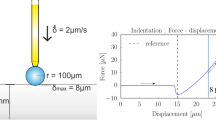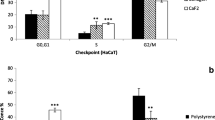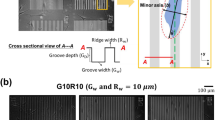Abstract
Cell–material interactions can on one hand be characterised by assessing the functional state and or shape of the cells at one or different discrete periods of time, on the other hand by observing cell migration and spreading behaviour. The object of this study was to investigate the migration behaviour of fluorescently labelled cells, and to evaluate the software analysing this migration. In the present study, the behaviour of fibroblasts cells on differently structured surfaces was taken as example. In the first step, the influence of seven different lipophilic dyes (DiI, DiO, DiA, DiD, DiR, PKH2 and PKH26) on cell performance was determined taking biochemical parameters as indices. In the second step, the fluorescence characteristics of these dyes were compared regarding their applicability. In the third step, migration behaviour of DiI-labelled fibroblastic cells on plane and grooved surfaces were monitored and analysed using specific software. Our data suggest that most of the dyes have optimal characteristics for studying cell – cell interactions. Cell migration behaviour regarding migration direction and cell spreading was different on plane and grooved surfaces. It could be shown that computer-based image analysis represents a practical, quick and objective tool to quantify exactly cell migration behaviour.
Similar content being viewed by others
References
D. A. Lauffenburger and A. Horwitz, Cell 84 (1996) 359.
K. Webb, V. Hlady and P. A. Tresco, J. Biomed. Mater. Res. 49 (2000) 362.
A. Curtis and C. Wilkinson, Biochem. Soc. Symp. 65 (1999) 15.
E. A. Cox, D. Bennin, A. T. Doan, T. O'Toole and A. Huttenlocher, Mol. Biol. Cell 14 (2003) 658.
B. Wojciak-Stothard, A. S. G. Curtis, W. Monaghan, M. McGrath, I. Sommer and C. D. W. Wilkinson, Cell Motil. Cytoskeleton 31 (1995) 147.
B. Chehroudi, T. R. Gould and D. M. Brunette, J. Biomed. Mater. Res. 23 (1989) 1067.
C. M. Lo, H. B. Wang, M. Dembo and Y. L. Wang, Biophys. J. 79 (2000) 144.
A. Curtis, C. Wilkinson and B. Wojciak-Stothard, Cell Eng. Inc. Mol. Eng. 1 (1995) 35.
M. G. Honig and R. I. Hume, J. Cell Biol. 103 (1986) 171.
P. K. Horan, M. J. Melnicoff, B. D. Jensen and S. E. Slezak, Meth. Cell Biol. 33 (1990) 469.
A. Bruinink, in “The Brain in Bits and Pieces” (M. T. C. Verlag, Zollikon, CH) p. 23.
D. M. Brunette, Exp. Cell Res. 167 (1986) 203.
E. T. Den Braber, J. E. De Ruijter, L. A. Ginsel, A. F. Recum and J. A. Jansen, Biomaterials 17 (1996) 2037.
A. Curtis and P. Clark, Crit. Rev. Biocomp. 5 (1990) 343.
S. Li, S. Bhatia, Y. L. Hu, Y. T. Shiu, Y. S. Li, S. Usami and S. Chien, Biorheology 8 (2001) 101.
Author information
Authors and Affiliations
Corresponding author
Rights and permissions
About this article
Cite this article
Kaiser, JP., Bruinink, A. Investigating cell–material interactions by monitoring and analysing cell migration. Journal of Materials Science: Materials in Medicine 15, 429–435 (2004). https://doi.org/10.1023/B:JMSM.0000021115.55254.a8
Issue Date:
DOI: https://doi.org/10.1023/B:JMSM.0000021115.55254.a8




